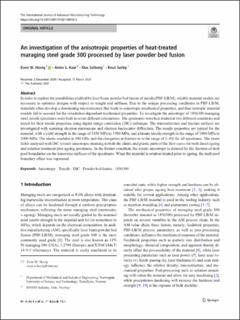| dc.contributor.author | Hovig, Even Wilberg | |
| dc.contributor.author | S. Azar, Amin | |
| dc.contributor.author | Solberg, Klas | |
| dc.contributor.author | Sørby, Knut | |
| dc.date.accessioned | 2021-04-08T09:07:03Z | |
| dc.date.available | 2021-04-08T09:07:03Z | |
| dc.date.created | 2021-04-06T09:00:43Z | |
| dc.date.issued | 2021 | |
| dc.identifier.citation | The International Journal of Advanced Manufacturing Technology. 2021, . | en_US |
| dc.identifier.issn | 0268-3768 | |
| dc.identifier.uri | https://hdl.handle.net/11250/2736794 | |
| dc.description.abstract | In order to explore the possibilities enabled by laser beam powder bed fusion of metals (PBF-LB/M), reliable material models are necessary to optimize designs with respect to weight and stiffness. Due to the unique processing conditions in PBF-LB/M, materials often develop a dominating microstructure that leads to anisotropic mechanical properties, and thus isotropic material models fail to account for the orientation-dependent mechanical properties. To investigate the anisotropy of 18Ni300 maraging steel, tensile specimens were built in seven different orientations. The specimens were heat treated at two different conditions and tested for their tensile properties using digital image correlation (DIC) technique. The microstructure and fracture surfaces are investigated with scanning electron microscope and electron backscatter diffraction. The tensile properties are typical for the material, with a yield strength in the range of 1850 MPa to 1950 MPa, and ultimate tensile strength in the range of 1900 MPa to 2000 MPa. The elastic modulus is 180 GPa, and the elongation at fracture is in the range of 2–6% for all specimens. The strain fields analysed with DIC reveals anisotropic straining in both the elastic and plastic parts of the flow curve for both direct ageing and solution treatment plus ageing specimens. In the former condition, the elastic anisotropy is dictated by the fraction of melt pool boundaries on the transverse surfaces of the specimens. When the material is solution treated prior to ageing, the melt pool boundary effect was supressed. | en_US |
| dc.language.iso | eng | en_US |
| dc.publisher | Springer Nature | en_US |
| dc.rights | Navngivelse 4.0 Internasjonal | * |
| dc.rights.uri | http://creativecommons.org/licenses/by/4.0/deed.no | * |
| dc.title | An investigation of the anisotropic properties of heat-treated maraging steel grade 300 processed by laser powder bed fusion | en_US |
| dc.type | Peer reviewed | en_US |
| dc.type | Journal article | en_US |
| dc.description.version | publishedVersion | en_US |
| dc.source.journal | The International Journal of Advanced Manufacturing Technology | en_US |
| dc.identifier.doi | https://doi.org/10.1007/s00170-021-06938-2 | |
| dc.identifier.cristin | 1902183 | |
| dc.description.localcode | This article is licensed under a Creative Commons Attribution 4.0 International License, which permits use, sharing, adaptation, distribution and reproduction in any medium or format, as long as you give appropriate credit to the original author(s) and the source, provide a link to the Creative Commons licence, and indicate if changes were made. The images or other third party material in this article are included in the article's Creative Commons licence, unless indicated otherwise in a credit line to the material. If material is not included in the article's Creative Commons licence and your intended use is not permitted by statutory regulation or exceeds the permitted use, you will need to obtain permission directly from the copyright holder. To view a copy of this licence, visit http://creativecommons.org/licenses/by/4.0/. | en_US |
| cristin.ispublished | true | |
| cristin.fulltext | original | |
| cristin.qualitycode | 2 | |

